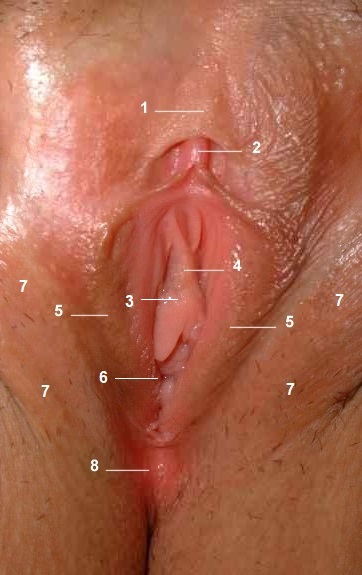First things first: please accept my profuse apologies for this post being a full week late. My husband and I were out of town last week looking at houses, as we're moving between states pretty soon, and it's been kind of a busy time. The next few weeks may see posts being early or late as we prepare to move.
Dear Readers, I am ludicrously excited to do this post. It's the reason I started this blog to begin with, and the whole hymen issue is something that gets my hackles up. We'll go into the social pressures around female virginity at some point, and the whole "purity" debacle, and what the "first time" is actually like, but I feel that this is one issue where the anatomical facts and the social expectations are of equal importance. So the hymen gets its own post. Yay!
I've taken classes in human sexuality 3 times in my life: an ongoing "Family Life" course over 5-7th grade, a religious studies elective in my senior year of high school, and a humanities elective during my second year of college. NONE OF THEM DISCUSSED THE REALITIES OF THE HYMEN. The college course touched a bit on the atypical hymens, but not one talked about what it really is.
If you're like me, you've grown up hearing phrases like "popping the cherry" as euphemisms for a girl losing her virginity. You've heard of things like a "torn hymen" and bleeding during sex as proof that it was her first time. You've seen shows like True Blood, where poor vampire Jessica can't have sex without pain because her crazy vamp healing abilities make her hymen grow back. You've seen things like Law and Order SVU where they say an intact hymen is proof that rape hasn't occurred. You've read Game of Thrones and similar stories where a girl's virginity is called into question, so she's examined by doctors or religious elders or midwives to determine if her hymen is still in place. Perhaps you grew up with a religious background that emphasizes female purity, and have been told that things like tampons can break the hymen.
You probably picture the hymen as something like this:
Ahh Cassandra, yours is the first episode of DW I ever saw.
Or, to use words, you picture it as a thin veil of tissue stretched across your vagina, a barrier or membrane that is torn or popped or broken when you have sex (or use a tampon, if my religious upbringing is to be believed).
And there is a type of hymen (called an imperforate hymen) in which this is the case.
But for most of us, the hymen is just a thin corona of mucusy tissue located an inch or so inside the vaginal opening. It's stretchy, and delicate, and actually wears away over time due to estrogen exposure and physical activity.
Your hymen is a unique snowflake. A beautiful, mucus-y snowflake.
Remember a few weeks ago I asked you to take out a mirror and identify the structures in the
vulva anatomy post? Let's do that again. Take a look at your vaginal opening (a flashlight may be helpful here) and see if you can identify anything that looks like a ring or crescent or squiggly shape just a bit inside. That's your hymen. Just that. It's nothing that will tear or pop during sex, or that any doctor or priest or midwife could look at and say, "Yep, she's a virgin." It's just a little flap of tissue, sort of like the webbing at the base of your fingers, only even thinner and stretchier and it fades away over time.
If, however, you do see a solid barrier, or a band of tissue running down the center, or a wall of tissue with one or several small holes in it, we may have a slight problem. While the hymens picture above are fairly typical and won't cause major problems with things like penetration, menstruation, or tampon use, there are several forms of hymen which can be problematic.
A chart showing typical and atypical hymen forms. The dark bit is the visible opening of the vagina
Image 1 is a "typical" or lunate hymen - thin, crescent-shaped, blocking very little of the vaginal opening. Image 2 shows a hymen that has shrunk or worn away significantly, leaving only small bits behind. Image 3 shows the "annular hymen" in which the hymen creates a ring around the entire vaginal opening. This is fairly typical in young children, with the hymen changing shape to images 1 or 2 around puberty, though it may persist into adulthood.
The first row of hymens are pretty typical and safe and don't generally require any sort of medical intervention to make tampon use, penetrative sex, or menstruation easier. Though if you have an annular hymen, penetration and tampons may be a bit uncomfortable, in which case you should talk to your doctor.
The hymens in rows 2 and 3, however, can often be very problematic and require minor surgery to correct.
Images 4 and 5 are what are called "septate hymens" meaning there are one or more bands of tissue extending across the vaginal opening - like the spetum in your nose that divides your nostrils. They tend to be thicker and less elastic than than those hymens in the top row, and can impede tampon use and penetrative sex. Tampons may become trapped behind the tissue band or be blocked from entering all together, and penetration can cause the bands to rupture (painfully and with quite a bit of bleeding) or may not be able to get through at all. Sometimes these bands will break on their own or stretch out enough that tampons, fingers, toys, or a penis can fit through on one side, but often you will need help from a medical professional to correct it.
I've heard stories of girls attempting to correct septate hymens through self-surgery. DO NOT ATTEMPT TO DO THIS YOURSELF. Firstly because the risk of things like infection, nerve damage, and extreme blood loss are extremely high when you don't know what you're doing; and secondly because it's something that can be fixed in minutes by your doctor, usually with only a local anesthetic and usually right there in the office.
Why can't all gynecologists look like David Tennant?
Seriously. They just numb you up, snip the bands, and stitch or cauterize the cuts. It takes less than an hour (some girls have said more like 20 minutes) and recovery is very quick. No muss, no fuss, you could be using tampons within a few weeks.
Images 6, 7, and 8 show hymens which almost completely block the vaginal opening and thus are generally referred to as semi-imperforate hymens. A cribiform hymen sort of looks like a colander (pasta strainer) - a solid membrane with several small holes in it which allow menstrual fluid to drain. The labial and microperforate hymens have just one opening - a long narrow one or a single small one, respectively. Any of these three will almost certainly make penetration and tampon use impossible (and any attempts extremely painful) and will need medical intervention. The surgery is very similar to the one for a septate hymen, but both the procedure and recovery will be a bit longer as there is more tissue being removed.
Image 9 is the most dangerous form of hymen - imperforate. This is the type of hymen most of us picture, or what we're taught is the typical hymen. It's that first image of Cassandra.
An imperforate hymen is a bitch indeed.
It's the solid veil of tissue extending across the entire vaginal opening. It's usually thick, not stretchy, and can be very, very dangerous.
See, if the typical hymen really were the mythical full-barrier hymen, girls would be dropping dead left and right... because menstrual fluid would never be able to escape. It would just build up inside the uterus and vagina, and would eventually cause sepsis or endometriosis - very painful, very dangerous.
The good news is that the imperforate hymen only occurs in 1-2% of women and can usually be diagnosed at birth or in early infancy. The other good news is that, whether it's corrected in infancy or adulthood, the procedure for correcting it is simple and low-risk, just as for the other atypical hymen types. Some doctors will perform the procedure under local anesthetic as for septate or semi-imperforate hymens, but others will recommend you be fully anesthetized (knock out) and have it done in an actual operating room. It's sort of like popping a balloon, but way gentler and less explosive and in far more sanitary conditions.
Matt Smith is really my 3rd or 4th choice for ideal gyno.
For a first-hand account of the difficulties of an imperforate hymen and the experience of the surgery, check out this article from XOJane:
It Happened to Me.
Next week we will take a closer look at the clitoris, which is even more amazing than you may think.















